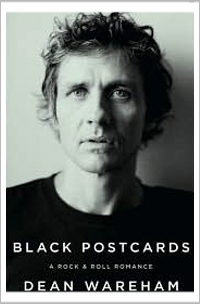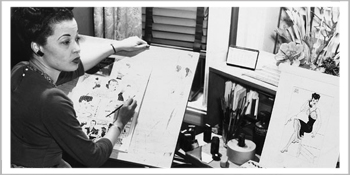By Steve Rhodes
Former Chicagoan Liz Phair penned a review in the New York Times on Sunday of Black Postcards: A Rock & Roll Romance, by indie rock hero Dean Wareham.
It’s a mess – Phair’s review, that is. We’ll look elsewhere to get a sense of Wareham’s book.
Phair’s opening paragraph starts with a highly questionable interpretation of a Freddie Mercury quote and ends by telling us that (while reading the book, apparently) “Dominick Dunne would make sure his seat was saved before excusing himself to use the restroom.”
Or, Dunne could take the book with him.
Let’s take a quick run through the rest of Phair’s effort.
 1. “His honesty is challenging and humbling. Yet, for an egghead (Wareham is a graduate of both the Dalton School, the progressive and prestigious Upper East Side preparatory academy, and Harvard) with an elective reading list to rival Art Garfunkel’s (Thomas Mann, Mark Twain, Andre Malraux, Nietzsche, to name a few), he seems perfectly happy to partake in whatever recreational opportunities come his way, with enviable disregard for the consequences. Guilty? Not guilty? What are we as a jury to think?”
1. “His honesty is challenging and humbling. Yet, for an egghead (Wareham is a graduate of both the Dalton School, the progressive and prestigious Upper East Side preparatory academy, and Harvard) with an elective reading list to rival Art Garfunkel’s (Thomas Mann, Mark Twain, Andre Malraux, Nietzsche, to name a few), he seems perfectly happy to partake in whatever recreational opportunities come his way, with enviable disregard for the consequences. Guilty? Not guilty? What are we as a jury to think?”
Because you can’t be an “egghead” and still, you know, enjoy sex and drugs. Further proof that Phair was an accidental indieist always destined for mainstream muck. (And the jury is to think, who the hell is this lame-ass square prosecutor?)
2. “After the big business of arena rock trampled through pop culture in the 1980s, with its smoke pots and high ticket prices, a fresh crop of homegrown bands espousing the D.I.Y. ethos, culled from the underground punk scene, suddenly came into vogue. A countercultural wave with roots in political and social activism swept the nation, culminating in the enormous success of bands like Nirvana and Pearl Jam. These self-proclaimed nerds conquered the world for a time, making up in originality and earnestness what they lacked in glitz and swagger.”
The marketing of Pearl Jam as an indie, punk or alternative band always (rightly) rankled Kurt Cobain, and Eddie Vedder himself said the band was no such thing. Unlike Cobain, Vedder was hardly a self-proclaimed nerd, and he hardly lacked swagger. Finally, the ascendancy of the indie rock scene had very little to do with any “countercultural wave with roots in political and social activism” sweeping the nation. If only that it did. It was, to be sure, in large parts about a different way of seeing and living life, including politically and socially. But it was also, sadly, as much about style, taste and fashion, and in any case hardly part of a movement “sweeping” the country, as opposed to pockets of resistance to the dominant culture.
3. “It’s as if a curtain were brushed aside and we all got to go backstage and experience the lives of those who ran away to join the circus: we ride in buses, drive in vans, count T-shirts, bicker with our bandmates, play shows, get courted and booted by record labels, make albums, fall head over heels and, throughout, rub elbows with countless influential artists of the day, crisscrossing the globe in tour trajectories so overlapping and incestuous it makes you want to call in a band traffic controller just to keep all the names straight.”
Um, didn’t Phair get to experience this in real life?
4. “One particularly unforgettable story involves the rags-to-riches-to-rags-again tale of a high-flying A & R executive at Elektra named Terry Tolkin, whose musical discernment never translated into the other areas of his life. Riding around in limousines, showing up late to work, throwing outrageous parties for artists and charging it all to the label, the surprisingly likable Terry finds himself on shaky ground as a corporate realignment threatens to squeeze him out of a job: ‘If he had signed just one platinum act, all would have been forgiven. Instead he gave them Luna, Stereolab and the Afghan Whigs.’ Things go from bad to worse, until ‘Terry had lost his wife, which he pretended not to care about. Now he had lost his job . . . Six months later he was working at a gas station in New Jersey, changing oil and brake liners by day, snorting heroin by night.”
This is particularly poignant, and connects Wareham’s book to the larger themes I’m guessing are the point, which Phair seems to be missing as she scans for tabloid material. If it’s not part of any larger themes by Wareham, then his target audience is very small indeed.
5. “Even his writing style has a rhythm to it: passages move rapidly back and forth between incident and impression, creating a kind of (I’m not kidding) rock ‘n’ roll.”
Please be kidding.
By the way, Phair follows that sentence, by noting that “If the writing suffers from a tone of detachment throughout, the author is well aware of it.”
So, in other words, the writing style is very indie rock.
I’m kidding.
Loose Juice
From a Sun-Times interview of F. Lee Bailey, who is promoting a new book:
Q. Many people believe O.J. Simpson was guilty of murder, despite his acquittal. When you try to persuade someone that Simpson was innocent, what do you emphasize?
A. There are three things that stand independently and are all inconsistent with guilt. The first is the timeline. [In the book, Bailey argues that Simpson did not have enough time to commit the murders, return home and catch a flight to O’Hare, as prosecutors claimed he did.] The second was the demeanor, which is extremely important in cases where people known to be non-criminals are involved in a murder case. And the third was his statement to the police, which I think . . . no guilty person with his background could possibly have pulled off. He spoke to them for three hours . . . and never slipped one bit. And a guy who had just killed two people the way these two were killed could never have done that.
Cartooning While Black
“Jackie Ormes, nee Zelda Mavin Jackson, was a journalist, artist, socialite and progressive political activist, a well-known figure in Chicago’s black community in the ’50s and ’60s,” the New York Times Book Review noted recently. “She was also, as the subtitle of Nancy Goldstein’s biography indicates, the first African-American woman to write and draw widely distributed comic strips: four different series, published between 1937 and 1956 in black newspapers including The Pittsburgh Courier and The Chicago Defender.

It was those breakthrough strips that truly marked Ormes as a Chicago – and American – original.
“The premise was simple: precocious kid Patty-Jo makes a wisecrack, and her big sister/guardian Ginger, another Ormes stand-in, hangs around striking pinup poses and looking glamourous in the latest styles. ‘Gee . . . it must be awful to have to have that Dior fella switch rules on you in the middle of the game,” Patty-Jo quips in one 1954 strip, as Ginger reads about the advent of a new Christian Dior line.’
Ormes was topical and top-shelf.
“In contrast to the images of African-Americans that prevailed in other pop culture of their time, the sisters are overtly upper class; they live in a well-decorated home, graced with fancy new products like plastic boots and a television. Patty-Jo comments on current events and occasionally pitches for the March of Dimes, sometimes at the same time. (‘MAO — ???’ she asks Ginger, who stands by attentively in toreador pants. ‘Golly, Sis, do you s’pose he’s any relation to old POLIO-MYE-LITIS? HE’S been attacking kids in their own neighborhood, an’ all we got to fight back with is volunteer DIMES!’)”
Ironically, Ormes’ various activities were catalogued in a 287-page FBI file “which didn’t mention her cartooning at all – and as the McCarthy red hunts and the civil rights movement gathered steam in the ’50s, the best jokes in Patty-Jo ‘n’ Ginger were often the most politically pointed.”
– Daniel Strauss contributing
Posted on April 10, 2008


